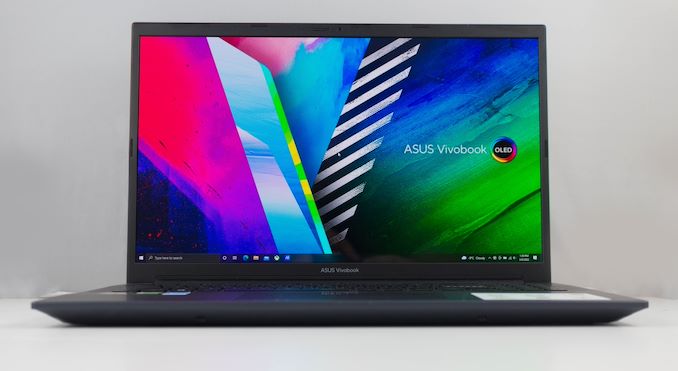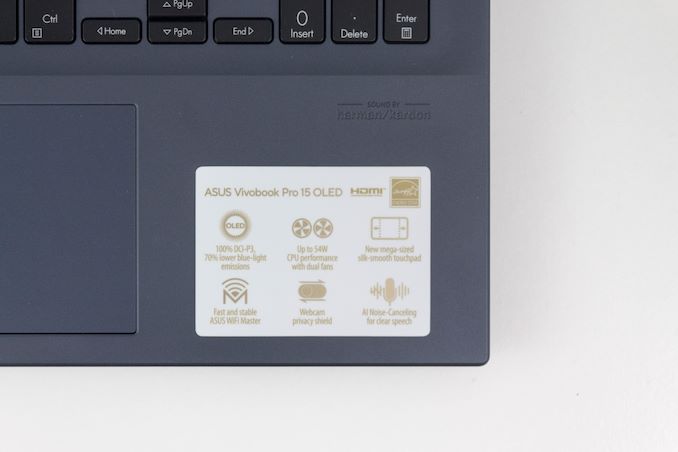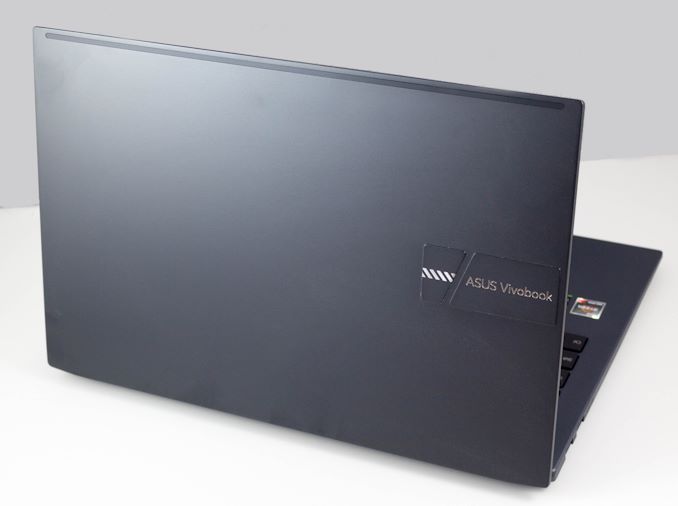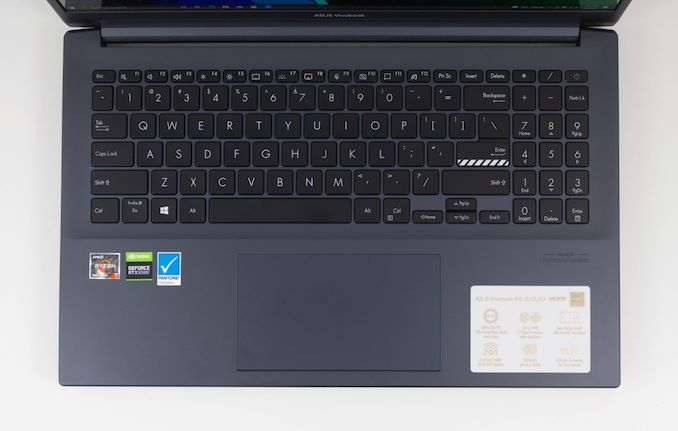The ASUS Vivobook Pro 15 OLED Review: For The Creator In All Of Us
by Brett Howse on March 7, 2022 8:30 AM EST
As the market for notebook computers has expanded, new product categories have been developed to fill the needs of a wider range of audiences, and one area that has been rapidly expanded in recent years is the Content Creator notebook. Demanding more performance than a typical thin and light notebook can provide, the creator notebooks fill a gap between gaming and light use, featuring extra graphics performance and CPU performance, while generally offering a subdued yet stylish form factor that still allows for portability.
ASUS has been building notebooks for this market for several years now, and today we are looking at the Vivobook Pro 15 OLED. The name kind of gives away the special feature of this device but including a 15.6-inch OLED display adds a major punch to the offering. Although OLED has not taken over the PC industry like it has the smartphone world, there is really nothing like the stunning contrast ratio OLED provides, as well as the wider color gamut most OLED devices support. In the case of the Vivobook Pro 15, that means 100% full coverage P3 gamut support.
ASUS provides both AMD and Intel versions of the Vivobook Pro, and the M3500 they have supplied us features the Ryzen 5000 Mobile series processors coupled with NVIDIA RTX Studio graphics. It ships with 16 GB of DDR4 RAM and 512 GB of SSD storage. Offering both AMD and Intel options is most certainly a nice feature. ASUS shipped this to us prior to the Ryzen 6000 launch and provided the Ryzen 7 5800H variant.
| ASUS Vivobook Pro 15 OLED | |||||
| Component | Ryzen 5 | Ryzen 7 Model Tested |
|||
| CPU | AMD Ryzen 5 5600H 6-core / 12-thread 19MB Cache 4.2 GHz max boost 45W TDP |
AMD Ryzen 7 5800H 8-core / 16-thread 24MB Cache 4.4 GHz max boost 45W TDP |
|||
| GPU | NVIDIA RTX 3050 Laptop Max-Q 2048 CUDA Cores 4GB GDDR6 128-bit |
||||
| RAM | 16GB DDR4 Soldered |
||||
| Storage | 512GB PCIe 3.0 SSD | ||||
| Display | 15.6-inch 1920x1080 OLED 100% P3 D65 Gamut PANTONE Validated 84% Screen-to-body ratio Glossy No Touch |
||||
| I/O | Left Side: 2 x USB 2.0 Type-A Right Side: 1 x USB 3.2 Gen 1 Type-A 1 x USB 3.2 Gen 1 Type-C 1 x HDMI 1.4 1 x 3.5mm headset Micro SD Power connector |
||||
| Networking | Wi-Fi 5 Intel 8265 Wireless NIC Bluetooth 4.2 Optional Wi-Fi 6 on some models |
||||
| A/V | Harmon Kardon speakers 720p webcam with privacy shutter |
||||
| Battery | 63 Wh Battery 120W AC Adapter |
||||
| Dimensions | 360 x 235 x 18.9 mm 14.17 x 9.26 x 0.74 inches |
||||
| Weight | 1.65 kg / 3.64 lbs | ||||
| Price (USD) | $920 | $1,099.99 | |||
There’s a reasonable amount of expandability of the device, which offers two USB 2.0 Type-A ports, a single USB 3.2 Gen 1 Type-A port, and a single USB 3.2 Gen 1 Type-C port. There is also a HDMI 1.4 connection, as well as a Micro SD card reader. For a device aimed at content creation, the port selection perhaps is not the best as a full-size SD card reader would have been preferred for offloading images from a camera, and the HDMI port rather than a DisplayPort is odd, although you can of course use an adapter from the Type-C port or HDMI to convert if needed.
ASUS offers up to Wi-Fi 6 in the Vivobook Pro 15, although the AMD review unit arrived with the Intel Wireless-AC 8265 network card which is Wi-Fi 5. It is one of the best Wi-Fi 5 devices around, thankfully.
ASUS offers the Vivobook Pro in two color choices as well. Prospective buyers can choose between Quiet Blue, which is what our review unit is, or Cool Silver.
The major feature though is definitely the OLED display. The 16:9 1920x1080 15.6-inch panel is undoubtedly the star attraction with incredibly rich blacks and vivid, punchy colors. We will of course dig into the display in more detail shortly.
ASUS packs quite a bit into the Vivobook Pro’s 1.65 kg / 3.6 lb package. Let’s dive in.
Design
The Vivobook Pro 15 OLED is a very traditional notebook design, with a 16:9 aspect ratio display that easily opens with one finger. The display back features an aluminum cladding while the main chassis of the device is polycarbonate. For the price point, ASUS has done a nice job here balancing cost versus feel, and the rigidity of the device is very solid.
The display bezels are reasonable thin, with ASUS stating the laptop offers an 84% screen to body ratio. The sides are thin and the top and bottom are wider which does help with the fitment of the webcam, although the webcam is only a 720p offering. It does offer a sliding privacy shutter which is a nice touch.
A 16:10 panel, such as the 14-inch version of this device offers, would have been a better fit with the product category as well. For content creators, having the extra vertical space on the display over a normal 16:9 panel allows for application controls while working on full-screen video.
Taking a look at the keyboard deck ASUS has fitted the Vivobook Pro 15 with a number pad to the left of the keyboard. This is always a compromise, especially on a 15-inch notebook, and does offset the keyboard to the left. ASUS was able to fit in full-size keys though and the keyboard feel is quite good. The key depressions are firm and offer a solid 1.35 mm of key travel, although they key caps themselves are flat and smooth. A bit more texture on the keys would have been nice, such as what ASUS offers on some of their ROG laptops. There is three levels of white backlighting which works well contrasting with the dark keys. ASUS does put the power button in the keyboard itself, which can cause issues accidentally pressing it, but thanks to the number pad the power button is not close to the delete key which should help.
ASUS has included an oversized touch pad in the Vivobook Pro 15 which works very well. It is incredibly smooth and responsive. It lacks some of the tactile feedback of the newer haptic touchpads but nevertheless is a good implementation. Despite the extra width, the palm rejection seems to work well as it never got in the way when typing.
The Vivobook Pro 15 offers a somewhat strange set of ports and the layout is also odd. The power connection as well as the faster USB ports are all on the right side of the notebook, which can get in the way if you were using it with a mouse and right-handed, as most people are, and the headset jack is also in the way. The power connector does offer a 90° connector which does help. Due to the 120-Watt AC Adapter, USB-C charging is not possible for maximum load, so ASUS has gone with a traditional barrel connector for power. The left side of the notebook has two USB 2.0 ports only. There is also a full-sized HDMI 1.4 port on the right side, as well as a micro SD card reader. A full-sized SD card reader would have been a better option for people wanting to pull files off a camera.
Where the Vivobook really shines though is its portability. Despite being a 15-inch notebook with a discrete GPU included, the Vivobook is still only 1.65 kg / 3.64 lbs. It is not quite a 14-inch notebook size, but the 84% screen-to-body ratio does help keep the overall dimensions in check. If you are looking for something with a proper 45-Watt processor and dedicated graphics, but still need to use it on the go, ASUS has done an excellent job on packaging.
















33 Comments
View All Comments
eek2121 - Monday, March 7, 2022 - link
Seems they didn't really try with higher end configurations. My Razer Blade 14 is slightly heavier at 3.94lbs, but beats this thing in everything except the OLED screen (though the refresh rate and resolution on the Razer Blade is much higher).matagyula - Monday, March 7, 2022 - link
I think it is worth pointing out that that Razer Blade 14 costs twice as much as the unit reviewed.Alistair - Monday, March 7, 2022 - link
so your laptop costs twice as much, is missing the main feature, the OLED screren, and it is miraculously faster? amazing stuff... /sbrucethemoose - Monday, March 7, 2022 - link
This isn't really a high performance gaming laptop. Asus has a compact ROG lineup to compete with the Blade more directly.relux - Monday, March 7, 2022 - link
While OLED screens are a boon for content consumption on mobile devices like phones, these smaller panels have advantages in high color accuracy, high brightness, high quality, etc. The review outright uses the word “terrible” to describe the accuracy of the display on this laptop. Windows has more static user interface elements than Android or iOS, creating greater risk of burn-in. OLED screens also tend to “smear” when pixels need to change from dark to light quickly, and this would surely be unpleasant in games or movies, and more noticeable on a larger screen. I’m left wondering, if the display is merely less accurate, more prone to degradation, and has unimpressive brightness to boot, why wouldn’t consumers prefer a quality LCD which will at the very least have better longevity?Doug_S - Monday, March 7, 2022 - link
Where do you get this idea that OLED pixels have problems changing brightness quickly? That's an LCD problem, OLED has no issue at all in that respect.itsAdamS - Tuesday, March 8, 2022 - link
Often the pixels on an OLED are turned off entirely when displaying black, and there's a delay to switch them back on again, greater than LCD response time, that leads to black smearing. I certainly notice this on my phone when scrolling something black but I haven't noticed this at all on my Asus OLED laptop -- they obviously chose response time over battery life and don't turn the pixels off completely.Doug_S - Tuesday, March 8, 2022 - link
That's not true at all. What you observe has nothing to do with response time, but a mismatch of screen updates and refresh rate.Oxford Guy - Sunday, March 13, 2022 - link
There is no laptop LCD with this much static contrast. So, define ‘quality’.If VA panels begin to appear then OLED might have some competition.
pjcamp - Monday, March 7, 2022 - link
You could do us a solid favor if you added two things to all your laptop reviews.1. Does it use proprietary peripherals? I never would have purchased a Dell XPS 13 had I known in advance that if you forget your Genuine Dell Charger, you're screwed. It refuses to charge without one.
2. See if Linux will install on it.